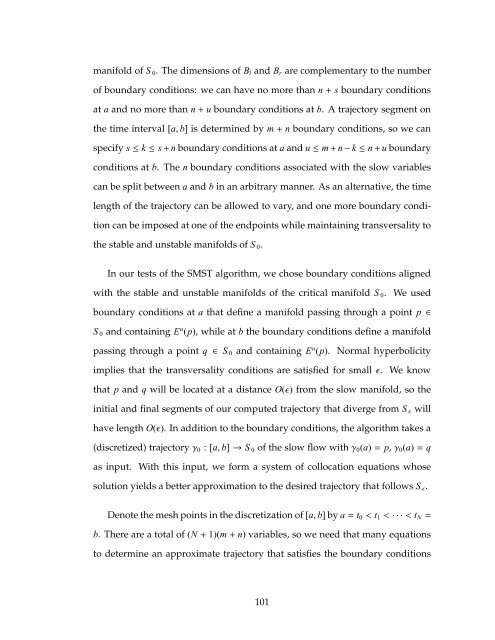multiple time scale dynamics with two fast variables and one slow ...
multiple time scale dynamics with two fast variables and one slow ...
multiple time scale dynamics with two fast variables and one slow ...
Create successful ePaper yourself
Turn your PDF publications into a flip-book with our unique Google optimized e-Paper software.
manifold of S 0. The dimensions of Bl <strong>and</strong> Br are complementary to the number<br />
of boundary conditions: we can have no more than n+ s boundary conditions<br />
at a <strong>and</strong> no more than n+u boundary conditions at b. A trajectory segment on<br />
the <strong>time</strong> interval [a, b] is determined by m+n boundary conditions, so we can<br />
specify s≤k≤ s+n boundary conditions at a <strong>and</strong> u≤m+n−k≤n+u boundary<br />
conditions at b. The n boundary conditions associated <strong>with</strong> the <strong>slow</strong> <strong>variables</strong><br />
can be split between a <strong>and</strong> b in an arbitrary manner. As an alternative, the <strong>time</strong><br />
length of the trajectory can be allowed to vary, <strong>and</strong> <strong>one</strong> more boundary condi-<br />
tion can be imposed at <strong>one</strong> of the endpoints while maintaining transversality to<br />
the stable <strong>and</strong> unstable manifolds of S 0.<br />
In our tests of the SMST algorithm, we chose boundary conditions aligned<br />
<strong>with</strong> the stable <strong>and</strong> unstable manifolds of the critical manifold S 0. We used<br />
boundary conditions at a that define a manifold passing through a point p∈<br />
S 0 <strong>and</strong> containing E u (p), while at b the boundary conditions define a manifold<br />
passing through a point q ∈ S 0 <strong>and</strong> containing E u (p). Normal hyperbolicity<br />
implies that the transversality conditions are satisfied for smallǫ. We know<br />
that p <strong>and</strong> q will be located at a distance O(ǫ) from the <strong>slow</strong> manifold, so the<br />
initial <strong>and</strong> final segments of our computed trajectory that diverge from Sǫ will<br />
have length O(ǫ). In addition to the boundary conditions, the algorithm takes a<br />
(discretized) trajectoryγ0 : [a, b]→S 0 of the <strong>slow</strong> flow <strong>with</strong>γ0(a)= p,γ0(a)=q<br />
as input. With this input, we form a system of collocation equations whose<br />
solution yields a better approximation to the desired trajectory that follows Sǫ.<br />
Denote the mesh points in the discretization of [a, b] by a=t0< t1
















